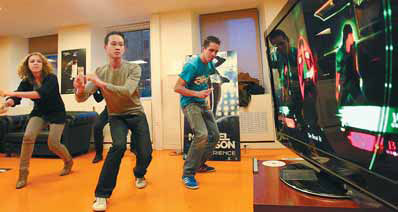Active video games not a fat fix
 |
|
A new study shows playing active video games burns more calories, provided there is no junk food. Provided to China Daily |
Active video games may help people burn more calories than couch-based screen time, a new study says. But those who play active games tend to undo most of the difference with junk food.
The study by the University of Texas Medical Branch found that active gamers tend to eat more calories than they spend dancing, playing hockey and drumming, for example. They take in an average of 376 more calories than they burn, compared to about a 650-calorie surplus among the inactive groups.
Although small, these differences can mean a lot in terms of energy balance when they are multiplied over days, weeks and years, says Dr Scott Leatherdale at the University of Waterloo in Canada. He has studied the effects of video games on energy use but was not involved in the study.
"There have been a couple of studies that have shown that TV watching and video playing increase eating, and they increase eating when compared to doing nothing," says Dr Elizabeth Lyons, who led the study at the University of Texas.
Lyons and her team assigned 120 experienced gamers aged 18 to 35, randomly, to watch TV, or to play sedentary or active video games.
They asked them not to eat for two hours before the mealtime-scheduled appointments, recorded their appetite level before each session began, and then observed them playing games or watching TV for an hour.
Subjects could watch shows including 30 Rock and The Office, or play games, such as Street Fighter IV to Dance Dance Revolution: Universe 2. Chocolate, chips, dried fruits and nuts and sodas were within easy reach. There was reason to believe that people would eat less if they were playing active games, Lyons says, "because it's physically difficult to eat while you're holding things, and while you're busier".
Yet when Lyons and her team looked at the difference between the groups, they found that while sedentary video gamers ate the most, averaging more than 747 calories during the hour long session, active gamers ate only slightly less, eating 553 calories on average.
The findings, reported in the American Journal of Clinical Nutrition, surprised researchers. "People will always find a way to eat," Lyons says. "No matter what group they were in they still ate a remarkable amount."
For Jacob Barkley, an exercise scientist at Kent State University, the findings still add to evidence that motion controlled games are not a fix for inactivity.
"It's not an adequate substitute for traditional physical activity, like a child going outside and playing in the yard, or an adult going to the gym, but it seems like a better alternative than watching TV or playing a traditional video."
But the study did have some limitations, Leatherdale says.
Barkley agrees. "If you're at home playing this game would you see the same kind of caloric intake? You wouldn't have the buffet of snacks available to you, which increases consumption."
"What we're finding more and more is that TV is uniquely awful for you," Lyons says. So even replacing a portion of your viewing time with an active game could be beneficial, she says.
"But the recommendation is: Get that food away from you! Don't have it on the couch with you, because you'll look up 10 minutes later and it'll be gone."
Reuters
















